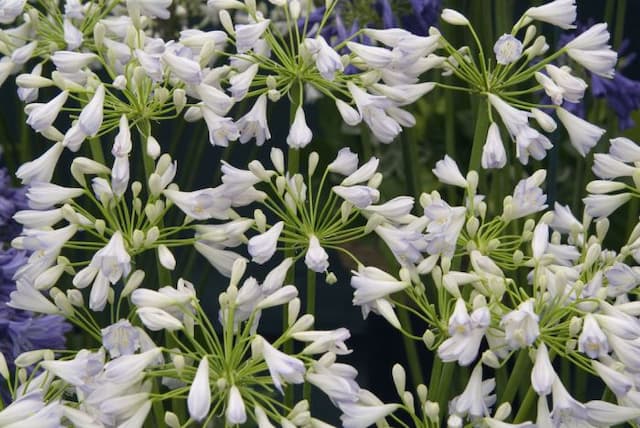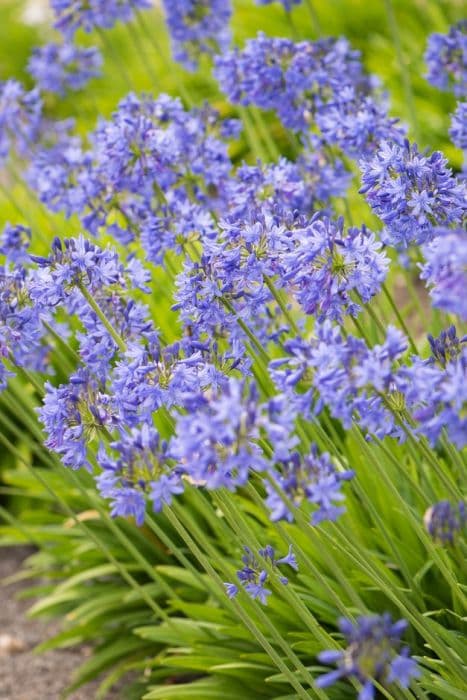Lily of the Nile Agapanthus 'Leicester'

ABOUT
The Agapanthus 'Leicester', commonly known as the Lily of the Nile, is a strikingly beautiful perennial that is cherished for its ornamental appeal. This plant is admired for its luscious clumps of strap-like, glossy green leaves that elegantly arch outward, creating a fountain-like effect. These leaves serve as the perfect backdrop for the plant’s crowning glory: its flowers. The floral display of the Lily of the Nile is nothing short of spectacular. The plant produces tall, sturdy stalks that rise above the foliage, each bearing a large, spherical cluster of trumpet-shaped flowers. These flowers are a deep, vibrant blue, and they bloom prolifically, creating a magnificent and bold visual impact. Each individual flower is comprised of six petal-like segments that spread outwards, cradling the plant's prominent stamens, which add an extra touch of elegance to the bloom. These flower clusters, also referred to as umbels, give the appearance of a fireworks display, bursting with color and life. As the flowers mature, they may slowly fade to a softer shade, retaining their beautiful form for an extended period before eventually withering away. Throughout the blooming season, the Lily of the Nile remains a focal point in any garden setting, drawing the eyes of passersby and providing a feast for pollinators, such as bees and butterflies, that are attracted to its nectar-rich blossoms. Overall, the Agapanthus 'Leicester' is a plant that exudes sophistication and charm, making it a beloved addition to any outdoor space where it commands attention through its stunning floral displays.
About this plant
 Names
NamesFamily
Amaryllidaceae.
Synonyms
African Lily, Lily of the Nile.
Common names
Agapanthus 'Leicester'
 Toxicity
ToxicityTo humans
Agapanthus, commonly known as Lily of the Nile, contains toxic substances that can cause symptoms if ingested. The plant's toxicity is due to its saponins and glycosides content. Symptoms of poisoning from agapanthus may include nausea, vomiting, diarrhea, abdominal pain, and dizziness. Contact with the sap may also cause skin irritation or allergic reactions in some people. Ingesting large amounts of the plant can lead to more serious consequences, so it is advised to seek medical attention if ingestion occurs.
To pets
Lily of the Nile is toxic to pets, particularly dogs and cats. Similar to its toxicity in humans, the plant contains compounds such as saponins and glycosides which can cause symptoms in pets if ingested. These symptoms include vomiting, diarrhea, abdominal pain, and occasionally excessive salivation. The severity of the symptoms can vary depending on the amount of plant material ingested. In severe cases, ingestion can lead to more significant health issues, and it is important to consult a veterinarian promptly if a pet has consumed any part of the agapanthus plant.
 Characteristics
CharacteristicsLife cycle
Perennials
Foliage type
Evergreen
Color of leaves
Green
Flower color
Blue
Height
2-3 feet (60-90 cm)
Spread
2-3 feet (60-90 cm)
Plant type
Bulb
Hardiness zones
8
Native area
South Africa
Benefits
 General Benefits
General Benefits- Ornamental Value: The Agapanthus 'Leicester', commonly known as the African Lily, is valued for its beautiful blue or purple flowers which can add aesthetic appeal to gardens and landscapes.
- Drought Tolerance: Once established, this plant is known for its ability to withstand periods of drought, making it suitable for xeriscaping and water-efficient gardens.
- Low Maintenance: African Lilies typically require minimal care once established, making them a convenient choice for gardeners of all skill levels.
- Attracts Pollinators: The plant's flowers are attractive to bees and butterflies, which can help pollinate other plants in the garden.
- Long Blooming Period: The Agapanthus 'Leicester' has a lengthy blooming season, from early summer to fall, providing long-lasting color in the garden.
- Resistance to Pests: African Lilies are generally resistant to pests, minimizing the need for chemical interventions and making them an eco-friendly option.
 Medical Properties
Medical PropertiesThis plant is not used for medical purposes.
 Air-purifying Qualities
Air-purifying QualitiesThis plant is not specifically known for air purifying qualities.
 Other Uses
Other Uses- The long, strap-like leaves of Agapanthus can be used in weaving or braiding for decorative purposes or to create small handicrafts such as baskets.
- The sturdy stems of the Apanthus can provide structural support to other plants in mixed flower arrangements, adding height and depth to the composition.
- Agapanthus flowers can be dried and used in potpourris, providing a gentle, lasting fragrance to a room.
- The sap from Agapanthus can be used as a natural adhesive in certain traditional crafts, although it is not as strong as modern glues.
- The flowers and leaves can be used as a natural dye, with the blossoms creating a light blue hue, while the leaves give a greenish color.
- Agapanthus can be planted as a privacy screen or living fence due to their bushy growth habit, providing a visual barrier in gardens.
- Gardeners may use split Agapanthus stems as a natural, biodegradable means of staking smaller plants in the garden.
- In some cultures, Agapanthus is considered a symbol of love and is used in wedding bouquets and decorations.
- Agapanthus is used in educational settings such as botany and horticulture programs to teach students about plant propagation and care.
- The substantial roots of Agapanthus can help in soil erosion control on slopes or areas prone to runoff.
Interesting Facts
 Feng Shui
Feng ShuiThe African Lily is not used in Feng Shui practice.
 Zodiac Sign Compitability
Zodiac Sign CompitabilityThe African Lily is not used in astrology practice.
 Plant Symbolism
Plant Symbolism- Love Letters: The very name "Agapanthus" is derived from the Greek words 'agape' meaning love, and 'anthos' meaning flower, symbolizing love letters or messages.
- Beauty: The striking blue to violet flowers of the Agapanthus 'Leicester' are often associated with beauty and a beautiful spectacle in the garden.
- Fertility: Agapanthus, with its lush foliage and bountiful blooms, can symbolize fertility and the abundance of life.
- Endurance: As a plant that can thrive in tough conditions and bloom annually, the Agapanthus represents endurance and persistence.
- Freedom: The Agapanthus 'Leicester', with its tall, upright stems and open flower heads may signify freedom and an openness to the world.
 Water
WaterAfrican Lilies should be watered regularly during their growing season in spring and summer, providing about 1 gallon of water per week. Ensure the soil is moist but not waterlogged as this can lead to root rot. During the winter months, reduce watering to every few weeks, just enough to prevent the soil from completely drying out. Allow the top inch of soil to dry between waterings to encourage deep root growth and prevent overwatering.
 Light
LightAgapanthus, commonly known as African Lily, thrives in full sun to partial shade. They perform best when they receive at least 6 hours of direct sunlight daily. The ideal spot for African Lily is a sunny border or a position where it can bask in the morning sunshine while being protected from the intense heat of late afternoon.
 Temperature
TemperatureAfrican Lilies prefer a temperate climate with ideal temperatures ranging between 50°F and 80°F. They can survive temporary dips down to 28°F but should be protected from frost. To ensure healthy growth, keep them away from extreme cold or heat, which can be detrimental to the plant.
 Pruning
PruningAfrican Lilies should be pruned to remove spent flower stalks and to tidy up any dead or damaged foliage. Pruning can be done after flowering in late summer or early fall. Regular removal of faded flowers may encourage a second bloom. Pruning helps maintain the plant's shape and promotes healthier, more vigorous growth for the next season.
 Cleaning
CleaningAs needed
 Soil
SoilAfrican Lily prefers well-draining soil with a mix of two parts loam, one part sand or perlite, and one part peat or compost. Soil pH should be around 6.0 to 8.0 for optimal growth.
 Repotting
RepottingAfrican Lily should be repotted every 2 to 3 years, or when the root system becomes crowded in the pot.
 Humidity & Misting
Humidity & MistingAfrican Lily thrives best in moderate humidity levels but is quite adaptable and can tolerate drier air.
 Suitable locations
Suitable locationsIndoor
Place African Lily in bright, indirect light indoors.
Outdoor
Grow African Lily in full sun to partial shade outside.
Hardiness zone
8-11 USDA
 Life cycle
Life cycleAgapanthus 'Leicester', commonly known as African Lily, begins its life cycle as a seed, which upon germination develops roots and a shoot that grows towards the light. The emerging shoot develops into a seedling with strap-like leaves that form a clump as the plant matures. Over time, the African Lily develops a stronger root system and, typically after a few years, will produce tall flowering stalks in summer bearing clusters of blue or white trumpet-shaped flowers. Once pollinated, usually by insects, these flowers produce seed pods that eventually dry and release seeds, completing the reproductive cycle. During autumn, the plant's foliage dies back, and it enters a period of dormancy through the winter months. In spring, new growth resumes from the base, continuing the perennial cycle of the Agapanthus 'Leicester'.
 Propogation
PropogationPropogation time
Spring to early summer
The most popular method of propagating the African Lily, specifically the Agapanthus 'Leicester', is through division. This is typically done in late winter or early spring before new growth starts. To propagate by division, carefully lift the clump of the plant from the ground with a shovel, ensuring to keep as many roots intact as possible. Gently separate the plant into smaller clumps, each with a section of roots and at least one growing point or shoot. After division, replant the sections immediately, watering them in well to help establish them. This simple process is effective because it maintains the characteristics of the parent plant and allows gardeners to quickly multiply their African Lily collection.









